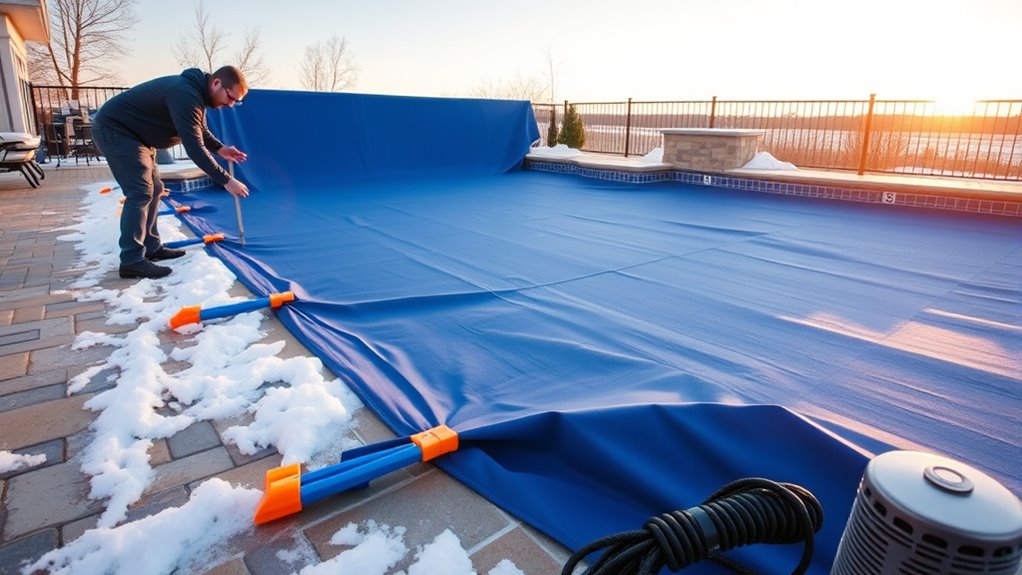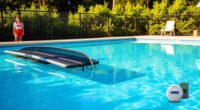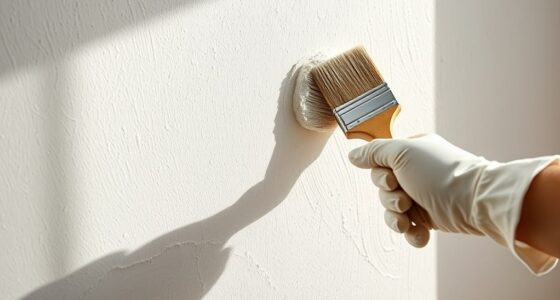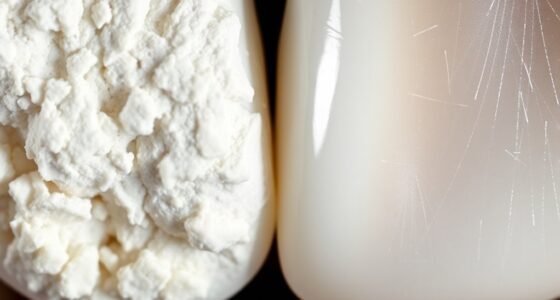To winterize your pool without worry, start by cleaning it thoroughly and balancing the water chemistry—you want pH between 7.2 and 7.6, with proper alkalinity and stabilizer levels. Lower the water below the skimmer, drain and store equipment safely, and add winter-safe chemicals like algaecide and stabilizer. Secure a quality cover to keep debris out. Following these steps guarantees your pool stays protected and ready for an easy spring start—discover more tips to make it flawless.
Key Takeaways
- Organize and inspect all equipment, tools, and supplies before cleaning and chemical balancing.
- Thoroughly clean the pool and balance water chemistry to prevent algae and corrosion during winter.
- Lower water levels below the skimmer, drain equipment, and store components in a dry, sheltered location.
- Use appropriate winter chemicals like algaecide, stabilizer, and sanitizers to protect your pool throughout winter.
- Secure the pool cover properly, remove winter plugs, and perform a final inspection before closing.
Gather Your Supplies and Prepare Your Workspace
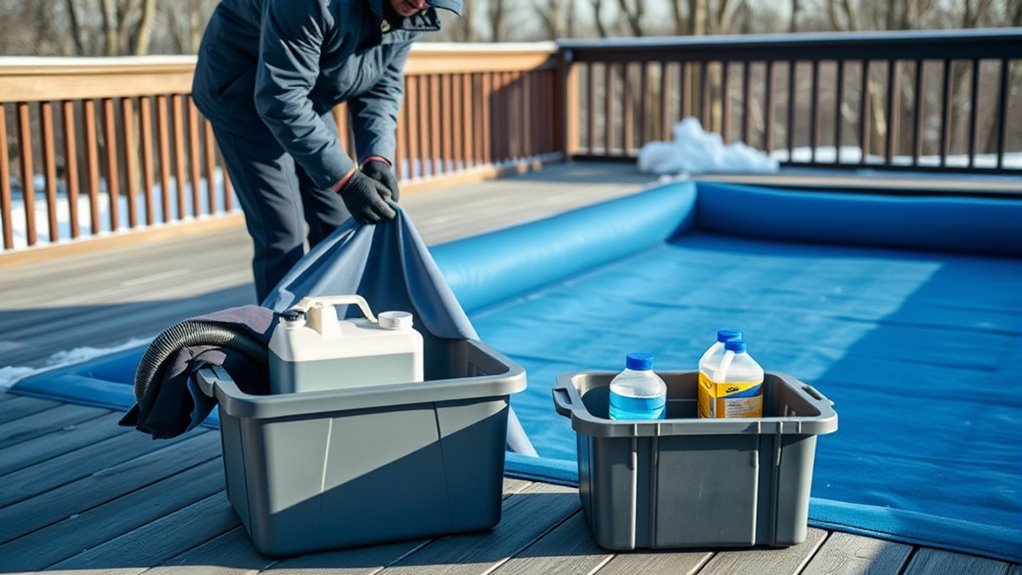
Before you begin winterizing your pool, it’s essential to gather all the necessary supplies and set up a clean, organized workspace. Start by collecting your pool cover, winterizing chemicals, a leaf net, a skimmer, a pool brush, and a telescoping pole. Make sure you have enough protective gloves, goggles, and a utility knife for any adjustments. Clear a nearby table or storage bin to keep your tools handy and prevent clutter. Check your supplies for expiration dates or damage to ensure everything works smoothly when needed. Having everything organized saves time and reduces stress during the process. Utilizing outdoor kitchen organization tips can help you create an efficient workspace. With your workspace ready, you’ll be well-prepared to move efficiently through the winterizing steps. Proper preparation makes winterizing safer and more effective.
Clean and Shock Your Pool Thoroughly
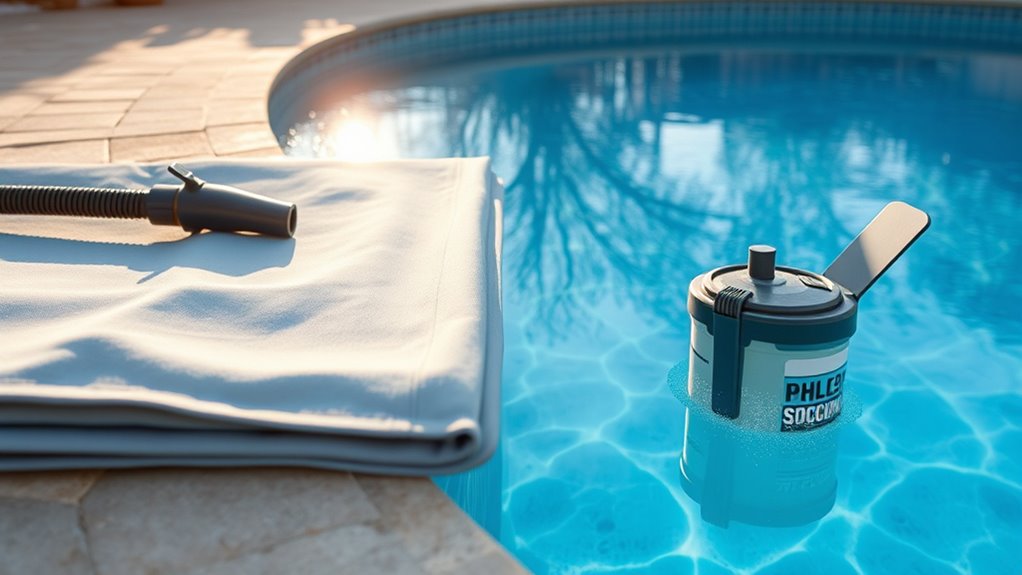
Make sure to remove all debris from your pool so the water stays clean and clear. Next, check and adjust the chemical levels, especially pH and alkalinity, to keep everything balanced. Finally, shock your pool to eliminate any remaining bacteria and algae before winter. To ensure optimal clarity, consider calibration of your water testing tools for precise chemical adjustments.
Remove Debris Completely
To guarantee your pool is properly winterized, you need to remove all debris completely. Clear out leaves, twigs, bugs, and dirt from the water and pool surfaces. Use a net or skimmer to scoop debris off the surface and vacuum the bottom thoroughly. This prevents staining and reduces organic matter that can cause algae growth over the winter. Once clean, shock the pool to eliminate bacteria and algae spores, ensuring a fresh start when you reopen it. Proper debris removal keeps your pool in top shape and simplifies spring reopening. Here’s a quick overview:
| Step | Equipment Needed |
|---|---|
| Remove floating debris | Skimmer net, leaf rake |
| Vacuum pool bottom | Pool vacuum, hose |
| Clean surfaces | Pool brush, algae scraper |
Regular maintenance during the off-season can also help prevent algae growth and keep your pool in pristine condition. Stay diligent to avoid future problems and protect your investment.
Balance Chemical Levels
Have you checked your pool’s chemical levels lately? Properly balancing your chemicals is essential before winterizing. Test your water using a reliable kit to check pH, alkalinity, and chlorine levels. Aim for a pH between 7.2 and 7.6, and alkalinity around 80-120 ppm. If pH is too high or low, adjust it with pH increaser or decreaser. Shock your pool with a powerful chlorine treatment to eliminate bacteria and organic contaminants. This step helps prevent algae growth during the off-season. After shocking, run your pump and filter for several hours to circulate the chemicals thoroughly. Ensuring the chemical balance is right protects your pool’s surface and equipment, making spring startup easier. Proper chemical management now prevents algae growth and other issues later.
Balance Water Chemistry for Optimal Protection
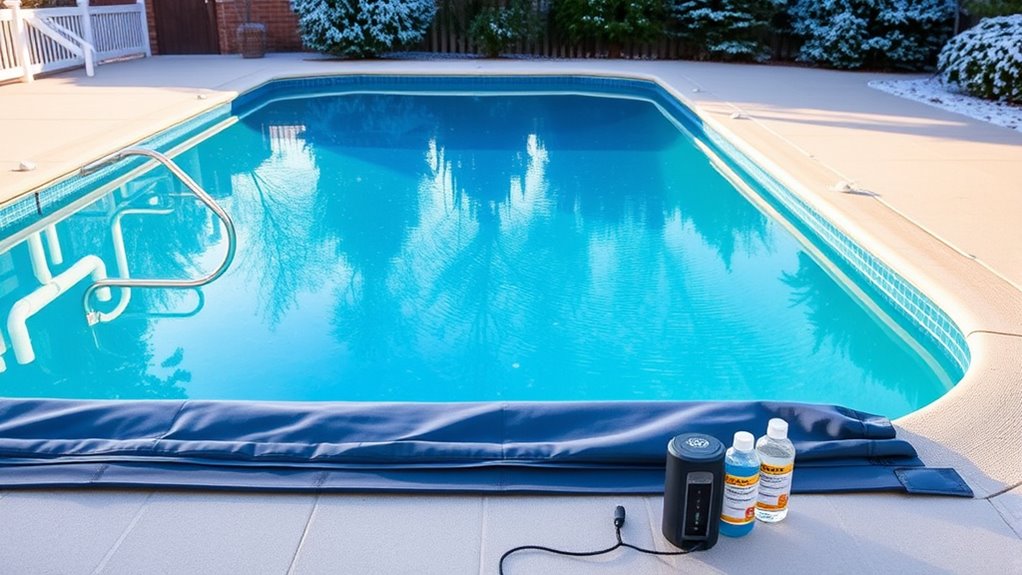
To safeguard your pool during winter, you need to balance the water chemistry properly. Adjust your pH and alkalinity levels to make certain they’re within the ideal range, preventing corrosion or scale buildup. Then, add the right winter chemicals to keep the water clean and prevent algae growth all season long. Additionally, using proper filtration methods can help maintain water clarity and quality throughout the winter months.
Adjust Ph and Alkalinity
Ever wondered why your pool’s water balance matters during winterizing? Proper pH and alkalinity levels protect your pool from corrosion, scaling, and staining during the off-season. Before closing, test your water with a reliable kit. Aim for a pH level between 7.4 and 7.6, and alkalinity around 80-120 ppm. If pH is too low, add pH increaser; if too high, use pH reducer. Adjust alkalinity first, then fine-tune pH. Maintaining balanced water prevents damage and keeps your pool in top shape for spring. Regularly monitoring water chemistry during winterization ensures optimal protection and prolongs the life of your pool equipment. Here’s a quick reference:
| Level | Target Range | Adjustment Needed |
|---|---|---|
| pH | 7.4 – 7.6 | Add pH increaser or reducer |
| Alkalinity | 80 – 120 ppm | Add alkalinity increaser or reducer |
| Water clarity | Clear and free of cloudiness | Test and adjust as needed |
Add Appropriate Winter Chemicals
After adjusting your pool’s pH and alkalinity, adding the right winter chemicals helps safeguard your water and equipment during the off-season. First, add a winterizing algaecide to prevent algae growth over the winter months. Next, introduce a stabilizer (cyanuric acid) if your chlorine levels are low, to maintain sanitizer effectiveness. Shock the pool with a winter-safe sanitizer to eliminate bacteria and organic contaminants. Consider adding a metal sequestrant if your water contains metals like iron or copper, which can stain the pool and equipment. Finally, include a winter chemical kit containing algaecide, stabilizer, and sanitizer, following manufacturer instructions. Proper chemical balance ensures your pool stays protected from corrosion, staining, and algae, making spring startup easier and less costly. Ensuring your water chemistry is correctly balanced is essential for maintaining a healthy, functional pool during the winter months, especially when using natural materials and rustic decor to create a cozy, inviting environment when not in use.
Lower the Water Level Appropriately
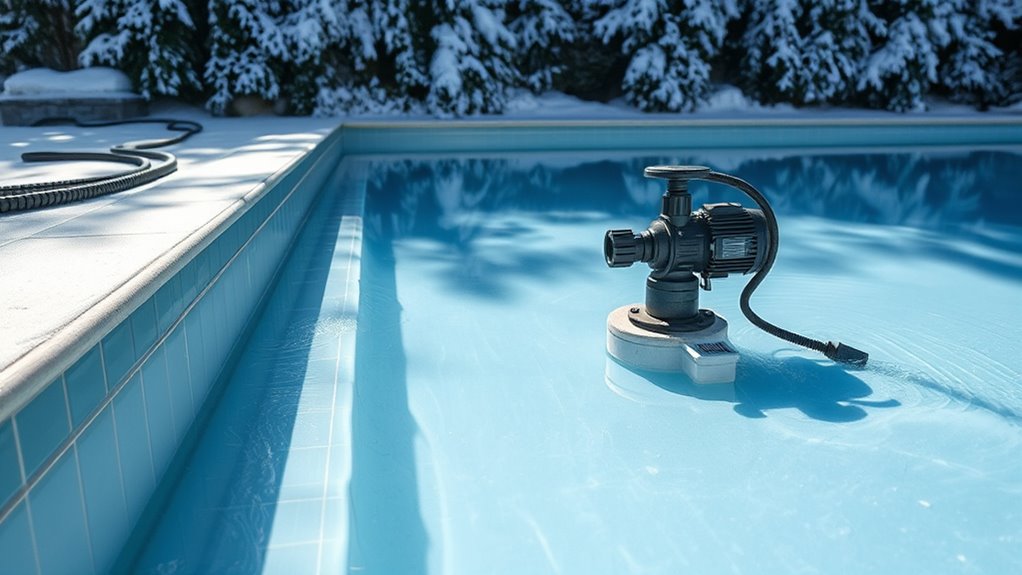
Lowering the water level is a crucial step to prevent freeze damage during winter. If the water remains too high, expanding ice can crack your pool’s walls or plumbing. To lower the water, use a submersible pump or the pool’s siphon system to remove excess water. Aim to lower the water below the skimmer opening, but not so low that it exposes the pool’s bottom or side walls. This prevents ice from forming directly against the pool surface. Be sure to check the manufacturer’s recommendations for your specific pool type. After draining, clean out debris and inspect the pool for any damage or weak spots. Proper water level management now ensures your pool stays protected throughout the cold months. Additionally, understanding pool construction materials can help you tailor winterization techniques to better suit your pool’s specific needs.
Drain and Store Pool Equipment
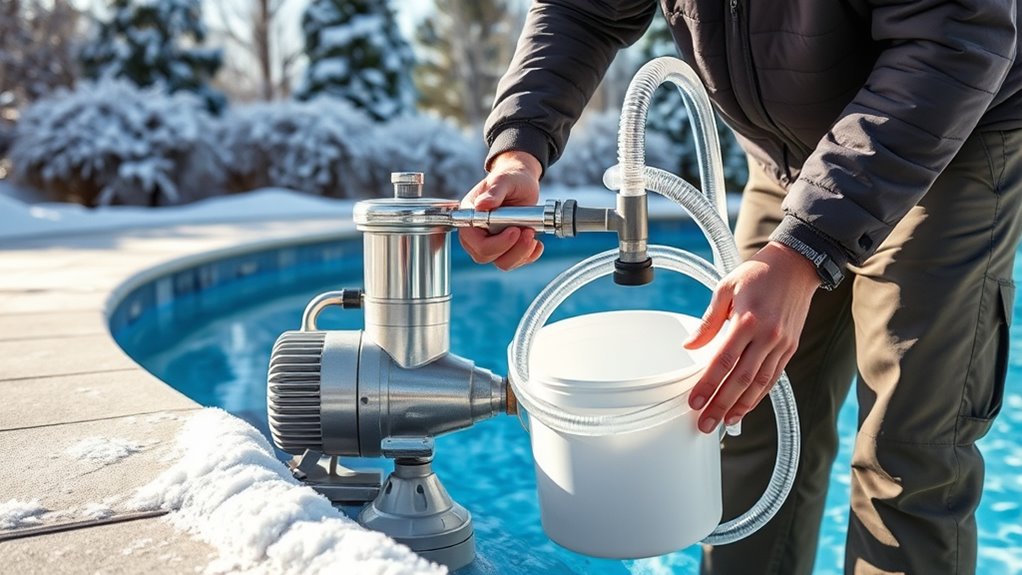
To protect your pool equipment during winter, you need to drain and store all removable components properly. Start by turning off the pool pump and disconnecting it from the filter and skimmer. Remove the pump, filter, and heater, and drain any water from these devices to prevent freezing damage. Carefully empty and dry out hoses, skimmer baskets, and any other accessories. Store all these components in a dry, sheltered location, such as a garage or shed, where they won’t be exposed to freezing temperatures. Be sure to inspect each piece for cracks or damage before storage. Properly draining and storing your equipment helps extend its lifespan and ensures it’s ready for a hassle-free start-up when swimming season returns. Additionally, reviewing equipment placement and ensuring proper storage conditions can further protect your investment.
Add Proper Winterizing Chemicals
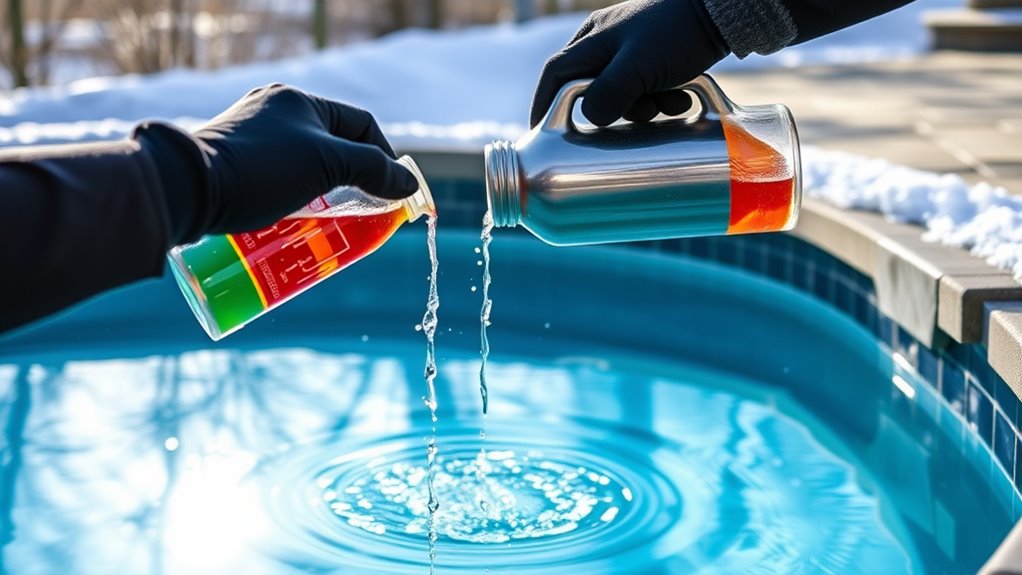
Adding proper winterizing chemicals is a key step in protecting your pool during the cold months. These chemicals prevent algae growth, scale formation, and corrosion that can damage your pool’s surface and equipment. Start by balancing your water’s pH, alkalinity, and calcium hardness. Then, add a winter sanitizer, such as chlorine or a non-chlorine alternative, to keep bacteria at bay. Using the right chemicals guarantees your pool stays clean and ready for easy reopening in spring. Here’s a quick overview:
| Chemical Type | Purpose |
|---|---|
| Algaecide | Prevents algae growth |
| Clarifier | Keeps water clear |
| Stabilizer | Protects chlorine from sunlight |
Proper chemical balance now conserves time and money later, especially considering the importance of water chemistry in maintaining pool health.
Protect Your Pool With a Cover
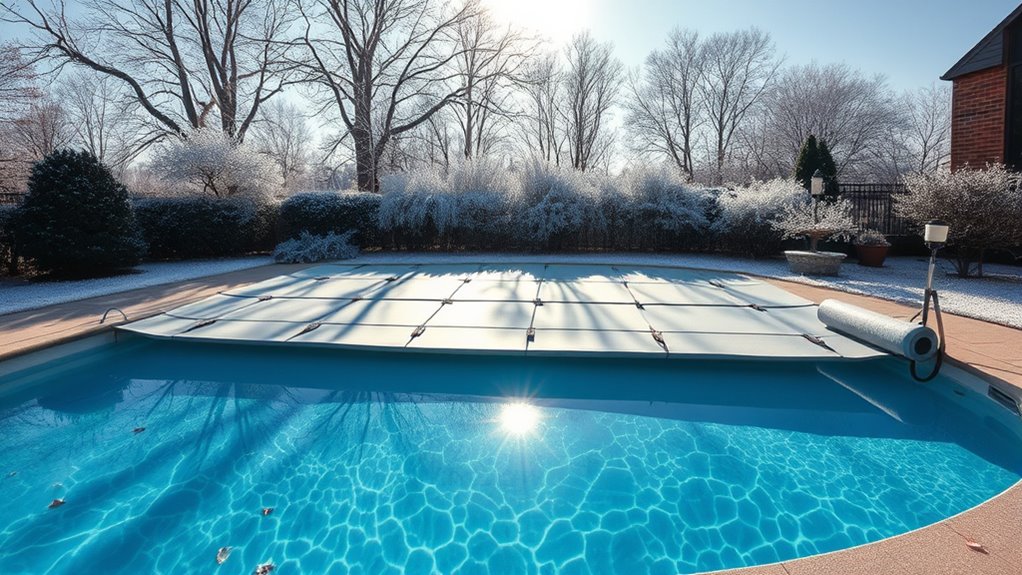
Have you considered how a pool cover can protect your investment during winter? A quality cover keeps debris, leaves, and dirt out of your pool, reducing the time and effort needed for cleaning in spring. It also prevents animals from falling in or nesting inside. Additionally, a sturdy cover helps maintain water temperature and reduces evaporation, saving you money on chemical and water replacement. Using a proper cover minimizes exposure to harsh weather, preventing algae growth and damage caused by ice expansion. Make sure you choose a cover suitable for your pool size and shape, and secure it tightly to avoid billowing or blowing away. With a reliable cover, you’re safeguarding your pool’s condition, extending its lifespan, and making your winter closing process much easier.
Final Inspection and Safety Measures
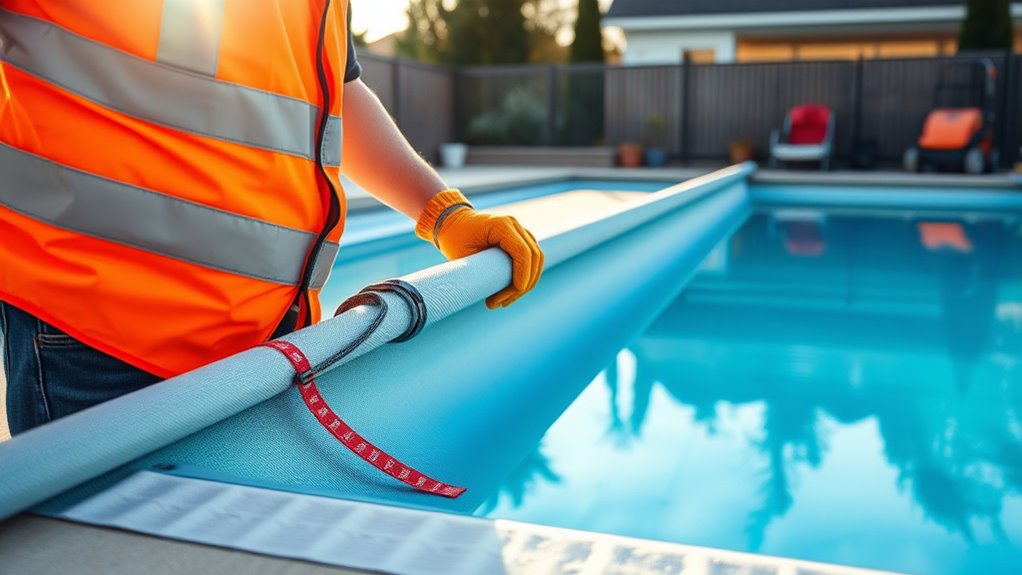
Did you remember to perform a final inspection before closing your pool for winter? Double-check that all equipment, such as pumps, filters, and skimmers, are clean and free of debris. Verify water levels are appropriate, and all valves are securely closed. Look for any leaks, cracks, or damage that might worsen over the winter months. Confirm that all safety measures are in place—remove any ladders or toys that could pose hazards if left in the pool. Make sure your pool cover is properly secured and free of debris that could cause damage or mold growth. Taking these steps now helps prevent surprises in spring and ensures your pool remains safe and protected during the cold months. A thorough inspection saves you time and effort when reopening your pool.
Tips for a Smooth Spring Opening
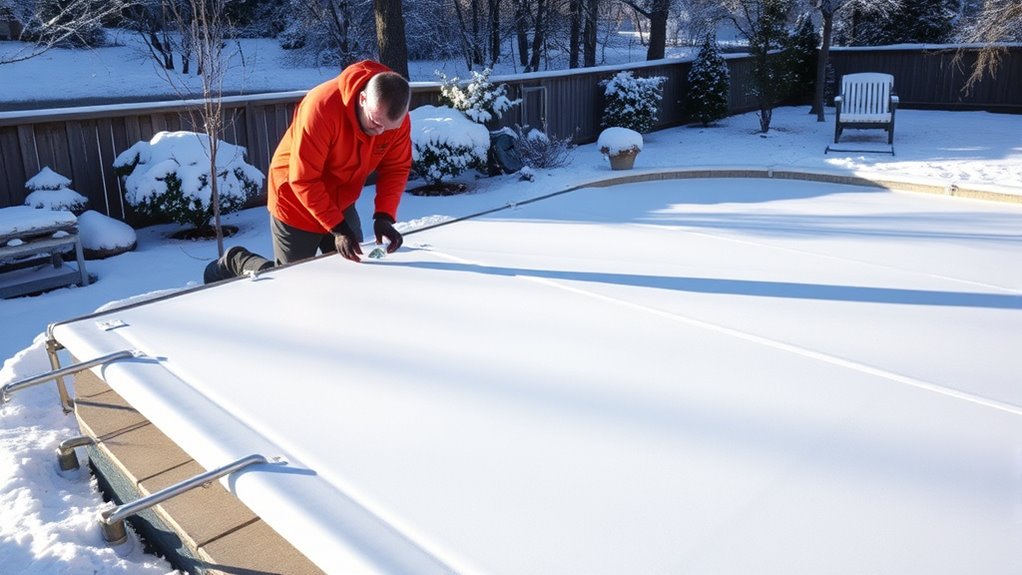
To guarantee your pool opens smoothly in spring, start by removing the winter cover carefully and inspecting it for tears or debris. Clear off leaves, dirt, and accumulated debris to prevent contamination when you restart the system. Once you remove the cover, check the pool’s water level; it should be slightly higher than the skimmer opening. Next, remove and clean any winterizing plugs, then reconnect your pump and filter system. Run your pump and check for leaks or blockages in your equipment. Test your water chemistry, adjusting pH, alkalinity, and sanitizer levels as needed. If you notice any debris or algae, perform a thorough cleaning and shock treatment before swimming. Properly opening your pool ensures a safe, clean, and enjoyable swimming season.
Frequently Asked Questions
When Is the Best Time to Winterize My Pool?
You should winterize your pool when the weather consistently drops below 55°F, typically in late fall. Wait until the water temperature is stable and the forecast shows no warm spells. This prevents damage from freezing temperatures. Make sure to complete the process before the first freeze, usually around late November or early December, depending on your location. Acting early guarantees your pool stays protected throughout the winter months.
Can I Winterize My Pool if I Live in a Mild Climate?
Yes, you can winterize your pool in a mild climate. Since temperatures rarely drop below freezing, you might delay closing your pool until late fall or early winter. Focus on maintaining proper chemical balance and cleaning. You may not need to fully drain the pool or use extensive coverings. Regularly monitor weather forecasts to decide the best time to winterize, ensuring your pool stays protected without unnecessary effort.
What Are Common Mistakes to Avoid During Winterizing?
You should avoid rushing the process, as skipping steps can cause damage. Don’t forget to thoroughly clean your pool and balance chemicals before closing it, since leftover debris and imbalanced water can lead to stains and algae growth. Failing to drain equipment properly can cause freezing damage. Also, neglecting to cover your pool securely leaves it vulnerable to debris and pests. Pay attention to these details for a smooth winterization.
Do I Need to Drain My Pool Completely?
Think of your pool as a sleeping giant—you don’t want it to wake up with damage. You don’t need to drain it completely unless you live in an area with freezing temperatures that can crack the shell. Usually, it’s best to lower the water level to just below the skimmer. This helps prevent ice damage, keeps debris out, and makes winterizing easier without risking a full drain.
How Often Should I Check My Pool During Winter?
You should check your pool at least once every two weeks during winter. Regular inspections help you spot issues like debris buildup, ice formation, or equipment problems early. If you notice any changes, address them promptly to prevent damage. Keep an eye on water levels and cover integrity, especially during storms or extreme cold. Staying vigilant guarantees your pool remains protected and ready for a smooth reopening when spring arrives.
Conclusion
Winterizing your pool is like putting a cozy blanket around it, ensuring it stays safe and protected until spring. By following these steps, you’ll keep your pool in top shape, ready for a quick, hassle-free opening when the warm weather returns. Think of it as giving your pool a well-deserved rest—so when the season changes, it’s refreshed and ready to dive back in. Stay diligent, and your pool will thank you for it.
